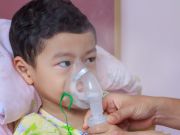Rates of Child Hospitalization Similar Between COVID-19, Flu: Study
By E.J. MundellHealthDay Reporter

TUESDAY, Sept. 8, 2020 (HealthDay News) -- While adults face raised odds for hospitalization with COVID-19, a new study shows that the risk for kids infected with SARS-CoV-2 is about equal to that seen with influenza.
The researchers found that kids with COVID-19 or the seasonal flu have similar rates of hospitalization, admission to intensive care units (ICUs) and ventilator use.
But the average age of children hospitalized differed: The average child hospitalized with COVID-19 was about 10 years of age, while kids hospitalized with flu average just over 4 years of age.
Symptoms shown at admission to the hospital also seemed to differ: More children with COVID-19 had fever, cough, diarrhea, vomiting, headache, body aches and/or chest pain at the time of diagnosis, compared to pediatric flu patients, the researchers said.
Much remains unknown about COVID-19, so the finding that children with the disease have more symptoms at the time of diagnosis than those with the flu is important, according to the study authors.
"It's a good cue from a prevention and planning perspective," study principal investigator Xiaoyan Song, director of infection control and epidemiology at Children's National Hospital in Washington, D.C., said in a hospital news release. "We always emphasize early recognition and early isolation with COVID. Having a clinical picture in mind will assist clinicians as they diagnose patients with symptoms of the coronavirus."
Song also stressed that the "collision of the flu and COVID-19 this fall could mean an increase in pediatric hospitalizations. That's why it's important to get your flu shot, because it can help take at least one respiratory virus out of circulation."
The study has "good news and bad news for children and parents," said pediatrician Dr. Michael Grosso, who wasn't involved in the new study.
"The good news is that the rates of hospitalization, ICU admission and need for mechanical ventilation were not statistically worse than for young people with the flu," said Grosso, who directs pediatrics at Huntington Hospital in Huntington, N.Y. "Given the severity of COVID-19 in older adults, this is good news," he explained.
"The bad news is that it wasn't better than the flu either," Grosso said. "We need to keep in mind that influenza remains a serious health risk in childhood, especially for those under 2, those with underlying health problems or both."
The new study included 315 children, median age 8.4 years, who were diagnosed with COVID-19 between March 25 and May 15, 2020. Their medical records were compared to those of more than 1,400 children, median age 3.9 years, who were diagnosed with seasonal flu between Oct. 1, 2019 and June 6, 2020.
Of the COVID-19 patients, about 17% ended up needing hospitalization, including nearly 6% who were admitted to the ICU and 3% who were put on ventilators.
Among the flu patients, just over 21% were hospitalized, 7% were admitted to the ICU, and about 2% were put on ventilators, according to the study published online Sept. 8 in JAMA Network Open.
In both groups, fever was the most common symptom at the time of diagnosis, followed by cough. Children hospitalized with COVID-19 were more likely than those hospitalized with the flu to have fever (76% versus 55%), cough (48% versus 31%), diarrhea or vomiting (26% versus 12%), headache (11% versus 3%), body ache (22% versus 7%), and chest pain (11% versus 3%).
The researchers also found that there was a sudden drop in flu cases at the hospital after local schools closed in mid-March and stay-at-home orders were issued about two weeks later to reduce the spread of the new coronavirus.
The effect of school closures on the spread of the coronavirus is the next focus of their research, the study authors said.
"We want to assess the quantitative impact of school closures so we can determine at what point the cost of closing schools and staying at home outweighs the benefit of reducing transmission of COVID-19 and burdens on the health care system," Song explained.
Grosso agreed that as flu season approaches, finding the answers to those questions becomes more urgent.
"What we don't know is how current social distancing efforts will influence the number of infected children or how many will get simultaneous infection with SARS-CoV-2 [the virus that causes COVID-19] and another virus," Grosso said. "We can only hope that these efforts -- and flu immunization at the earliest possible time -- will protect kids from the worst of these viral infections."
More information
The American Academy of Pediatrics has more on COVID-19.

The news stories provided in Health News and our Health-E News Newsletter are a service of the nationally syndicated HealthDay® news and information company. Stories refer to national trends and breaking health news, and are not necessarily indicative of or always supported by our facility and providers. This information is provided for informational and educational purposes only, and is not intended to be a substitute for medical advice, diagnosis, or treatment.

